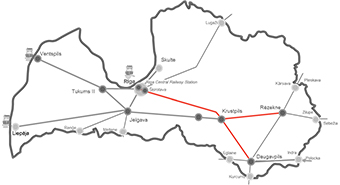The project will electrify 308 km of Latvia’s main east-west railway network to replace diesel-powered locomotives. This is expected to increase transport efficiency, encourage the use of environmentally friendly technology and align the country’s infrastructure with the requirements of EU and national regulations for core railway network development. The overall aim is to strengthen the international competitiveness of the Latvian railway transport corridor.
Electrification of Latvia’s east-west rail corridor to boost economic development
- 05 June 2019
The national transport development strategy document – Transport development guidelines for 2014-2020 – makes the extension of electrified railway lines by 20 % a priority. At present only 14 % of Latvia’s rail network is electrified. The EU average is 55 %.
The project will provide for :
electrification of the Riga–Krustpils line: 8 km of double track network from Riga central station to Šķirotava, Riga, and 134 km from Šķirotava to Krustpils; electrification of the single-track rail network from Krustpils to Daugavpils (80.5 km);electrification of the single-track rail network from Krustpils to Rēzekne (85.5 km); replacing the overhead contact line (OCL) in the Riga rail node – 6 km of double-track network west of Riga station.A total of 758.5 km of overhead contact lines will be installed to cover the aforementioned sections. The catenary system is designed to allow for a maximum speed of 160 km/h for passenger trains and 120 km/h for freight trains.
Four substations in Riga (Zasulauks), Krustpils, Rēzekne and Daugavpils and high-voltage grid connections will be provided. Outdated signalling equipment will be replaced and communications systems improved. A modern supervisory control and data acquisition equipment (SCADA) system will be put in place and the depot in Daugavpils will be adapted to service and maintain electric locomotives.
Reducing energy dependence
Electric traction is currently only used for passenger transport, and diesel power for goods transport. The project’s investment in modern technology will make operations along Latvia’s east-west rail corridor more efficient, competitive and environmentally friendly, and contribute to improving the country’s economic output. Substituting diesel locomotives with electric ones that run on locally generated electricity will improve Latvia’s energy independence, reduce transport costs and pollution.
Russia-EU trade
Between 40 million and 50 million tonnes of freight is hauled through Latvia annually and goes through the country’s two main ports – Riga and Ventspils. Much of it is oil, oil products, coal, or fertiliser and comes from Russia, Ukraine, Belarus and Kazakhstan. More coal is expected to come through Latvian ports due to increased Russian coal production. It is shipped on to customers in the UK, the Netherlands, Turkey, Germany and Poland.It is anticipated that the reduced cost of transporting freight through the Baltic states will result in more volume flowing through the country, which will boost economic development and employment.
Latvia is looking to reduce dependency on Russia–EU trade due to sanctions and political uncertainty about trade relations between these two blocs. Other potential sources of freight traffic Latvia is keen to attract are from China into Europe and from India via Iran and Latvia into Europe.
Total investment and EU funding
Total investment for the project “Latvian railway electrification” is EUR 533 582 065, with the EU’s Cohension Fund contributing EUR 318 556 362 through the “Growth and Employment” Operational Programme for the 2014-2020 programming period. The investment falls under priority Axis 6 “Sustainable Transportation System”.

